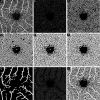Assessing the Sensitivity of OCT-A Retinal Vasculature Metrics
- PMID: 37531114
- PMCID: PMC10405864
- DOI: 10.1167/tvst.12.8.2
Assessing the Sensitivity of OCT-A Retinal Vasculature Metrics
Abstract
Purpose: The purpose of this study was to examine the sensitivity of quantitative metrics of the retinal vasculature derived from optical coherence tomography angiography (OCT-A) images.
Methods: Full retinal vascular slab OCT-A images were obtained from 94 healthy participants. Capillary loss, at 1% increments up to 50%, was simulated by randomly removing capillary segments (1000 iterations of randomized loss for each participant at each percent loss). Thirteen quantitative metrics were calculated for each image: foveal avascular zone (FAZ) area, vessel density, vessel complexity index (VCI), vessel perimeter index (VPI), fractal dimension (FD), and parafoveal intercapillary area (PICA) measurements with and without the FAZ (mean PICA, summed PICA, PICA regularity, and PICA standard deviation [PICA SD]). The sensitivity of each metric was calculated as the percent loss at which 80% of the iterations for a participant fell outside of two standard deviations from the sample's normative mean.
Results: The most used OCT-A metrics, FAZ area and vessel density, were not significantly different from normative values until 27.69% and 16.00% capillary loss, respectively. Across the remaining metrics, metric sensitivity ranged from 6.37% (PICA SD without FAZ) to 39.78% (Summed PICA without FAZ).
Conclusions: The sensitivity of vasculature metrics for detecting random capillary loss varies substantially. Further efforts simulating different patterns of capillary loss are needed for comparison. Additionally, mapping the repeatability of metrics over time in a normal population is needed to further define metric sensitivity.
Translational relevance: Quantitative metrics vary in their ability to detect vascular abnormalities in OCT-A images. Metric choice in screening studies will need to balance expected capillary abnormalities and the quality of the OCT-A images being used.
Conflict of interest statement
Disclosure:
Figures





References
-
- Ersoz MG, Hocaoglu M, Sayman Muslubas I, Arf S, Karacorlu M. Macular telangiectasia type 2: Acircularity index and quantitative assessment of foveal avascular zone using optical coherence tomography angiography. Retina . 2020; 40(6): 1132–1139. - PubMed
-
- Zeimer M, Gutfleisch M, Heimes B, Spital G, Lommatzsch A, Pauleikhoff D.. Association between changes in macular vasculature in optical coherence tomography- and fluorescein- angiography and distribution of macular pigment in type 2 idiopathic macular telangiectasia. Retina . 2015; 35(11): 2307–2316. - PubMed
Publication types
MeSH terms
Grants and funding
LinkOut - more resources
Full Text Sources

